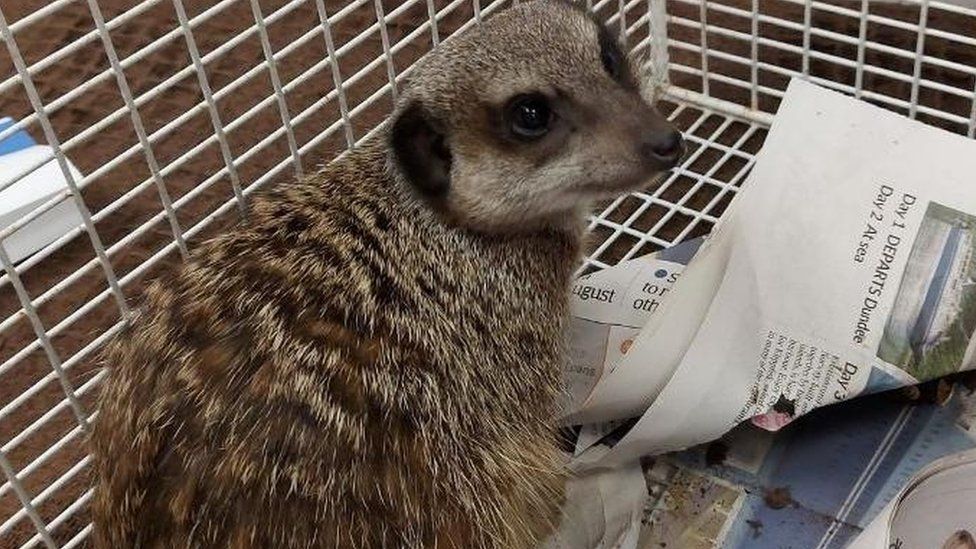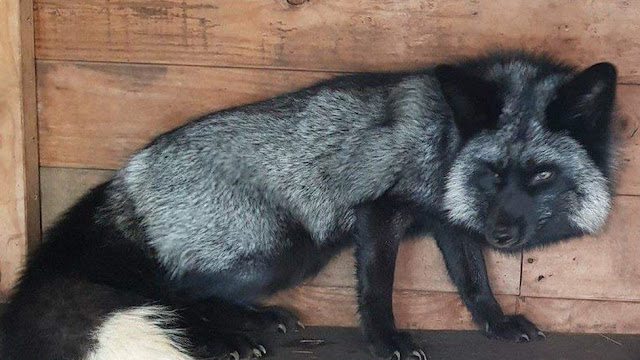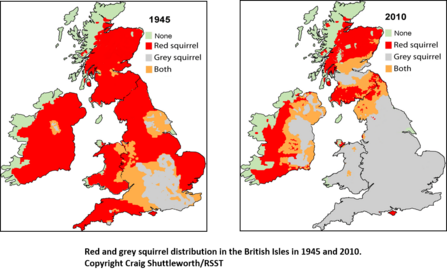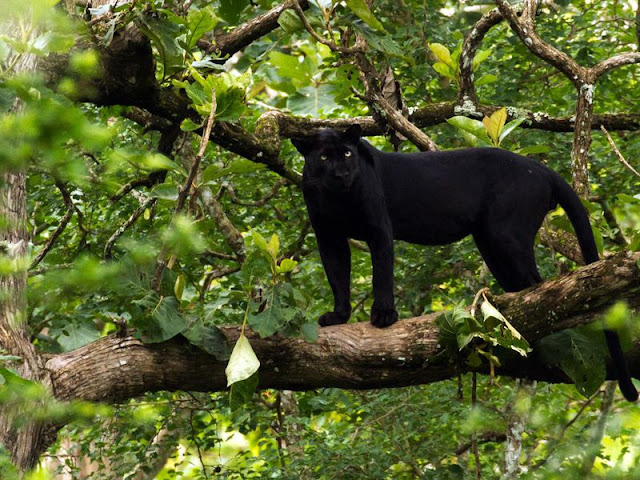I want to put a few
thoughts here so I know where they are when I need them. As usual I am typing
as I am thinking.
Trying to update the fox
work has become a lot weirder because of, in the main, black foxes. Also, odd
though this may sound, better communications.
When I first started out
there were no computers or mobile phones (please, do not faint -it was quite
normal for us and we never suffered). You had to put an appeal in newspapers or
talk to people and record what they had seen. You would ask for a detailed
description and the response was very likely going to be: "Oh, right you
are. It was a fox" and that was it.
I only noticed differences
in fox fur patterns after studying a lot of footage and many photographs but
even then nothing extreme in morphology. While running the Exotic Animals
Register (EAR) I would speak to many people and ask what other sort of wildlife
was in the area and apart from foxes being rarely seen I would get mentions of
(in one case from a lady who was a night time taxi driver in Devon) of black
foxes -not seen once but on several occasions. Then someone mentioned white
foxes and it got slightly confusing when to this were added black and white or
a small white or small black foxes seen in the Scottish borders area -all ridiculed
until one was shot for "looking unusual". Then I traced back the
releases of arctic foxes. Hayley de Ronde of Black Foxes UK has studied this
matter and discovered a great deal about the once legal fox fur trade and fox
farms in the UK.
Most people who had foxes
visiting them, like the badger feeders, kept these quiet for obvious reasons
(yes, there are people out there snatching foxes in towns and cities and
we can only guess why though we do know fox baiting was taking place in the
Midlands a few years back). Now a black fox could have been either a melanistic red fox or silver fox
-all I had to go on was "a black fox" (raccoon dogs do not help in
the confusion!).
But it seems that since
the 1990s there are more black foxes being reported and I'm not sure if that is
because more people are now wildlife aware or because of other factors. It may
well be likely that many of the black foxes reported are fur farm escapees or
dumps and that puts this in the same scenario as the non native cat issue.
I know that non native
cats were kept in private as well as travelling menageries and escapes from
these were not rare -even primates such as gorillas as I noted in one of my
earlier books-and there is a very great suspicion that "excess stock"
that could not be exchanged or sold off 'escaped' along some of the rough roads
menageries often travelled. Oh, UK
fox hunts releasing jackals, wolves and coyotes and even wolves for the ‘sport’
when they had almost wiped out the British fox added to the mix.
Now the press in the old
days often reported any animal sighted as "probably having escaped from
some travelling menagerie" as that was an easy explanation. True, there
were gorilla and chimp escapes, wolverines escaping and even humorous accounts
of kangaroo escapes. I know areas of England where cats have lived and
bred and been known about by locals since the 1920s/1930s and each generation
has warned the next of precautions to take if they come across one of the cats.
The public at large knows none of this because the cats are seen as wildlife
that takes care of the less wanted critters such as rats, mice and rabbits
–foxes are also on the menu.
Sightings of 'big cats'
are always funny season items or in today's sensationalist medium either funny
or “Deadly Killers At Large!!!” (yes,
even when some photos do only clearly show a domestic cat or dog and the zoos
that tell repoirters “it could be a large cat” really need to have their
training stepped up). Country shooters who work nights on farms "pest
controlling" have told me of well known local large cats and they never
attempt to even shoot them because "they help in the job". None of
this is widely known.
If someone saw a black fox
in the past they might mention it but who cares? It is either an "omen of
ill will" so keep quiet or so rare "you were lucky to see it".
No one -because it was a
blind spot in the public vision- thought about fur farms and if they knew of an
escape they probably thought to be quiet and "let it live its life in the
wild".
Being a joke or after
effect of ‘too much drink’ cat reports were never seriously looked into but we
know that they were either kept in pairs when they ‘escaped’ or were freed or a
male found a female and they were breeding: there is an absolute piece of pure
fantasy that is often cited by certain people claiming to be “big cat” experts
(X= The Unknown and “spurt” is a drip under pressure) that if there is, say, a
female puma in Wales and a male puma in Cumbria, the male will travel all the
way to Wales hence why a cat is reported for a few days then it is gone. That
is double-dumb-ass-with oakleaf cluster talk.
Have the cats really bred,
though? Well, unlike the copy and paste “experts”
I do the research work. I have a book,
reminiscences of a clergyman in the 19th century in which he
recounts an incident from the late 1840s in which a woman saw and perfectly
described a black leopard near a Devon
village. However, the locals assumed that this was a ghost because a coffin
being transported to a church was dropped on the same road earlier. A ghost was
far more likely an explanation –a leopard was not even considered! Other
reports point to similar instances going on around the UK and even during the
early years of WW 2 (before any US troops brought
any type of exotic to the UK –another “experts” fantasy).
I have a letter from a
nurse who used to visit Chester Zoo and would always visit the puma there (her
favourite) and when, in the 1970s she saw one in the countryside and close to
she KNEW it was a puma. But there was another smaller cat, spotted and the best
she could describe it as was a "sphynx cat" and when I asked for more
details I told her that what she saw was a puma cub (she had never seen one
before).
Now we get "blur
cat" photos or video footage of these cats and still no one really
believes -this attitude is helped by "big cat" groups and bad
reporting.
And the cats have a good
diet out in the wild. These cats whether African wild cats, jungle cats, lynx
or puma have been in the UK for at least two centuries and in that time not one
person has been harmed by one. There have been faked incidents but there is
only one genuine incident I can think of and that involved a scratch (very
light) from a lynx that a woman received when she tried to take a wild rabbit
it had killed from it –I have no idea why
anyone would do something that daft.
So we are now getting
reports of black fox cubs (but all fox cubs are black so...) but far more
people are noticing and photographing and filming black foxes so we can tell what
is a melanistic red fox or a silver fox. Recent escapees or the current
generation of offspring of escapees that have realised, as red foxes have, that
humans chuck food out willy-nilly so why struggle looking for rabbits during
hard times or when there are extra cubs to feed? (yes, the correct term is “kit”
but using that term usually gets blanks looks but you say “cubs” everyone knows
what you mean!)
Unlike the large cats we
have to look at whether escapee offspring are moving into towns (which they
have not though they are observed on the outskirts –as are rats and rabbits) and
whether this might lead to interbreeding between the red fox and North American
Silver fox –the silver fox is a domesticated
pet fox.
I was once told that if I
received one or two reports (totally different field) of something to plot them
on a map. Then I ought to go back a year and see whether there were similar
reports and plot those on a separate map. And I ought to do this for each year
I could find reports. I did that with cats and found there were territories as
well as patterns. On a combined map it looks impressive!
What the mapping showed me
were how reports increased but more importantly no one was told of the sighting
reports - until they contacted me.
I can see the same thing
happening with black/silver foxes. In this case the only way to tell if silver
foxes have bred "in the wild" is if photos or film turns up showing a
really young individual and this is why licensing or registration of these
foxes is needed because you have to ask whether this was a young individual bred
from two pets and it escaped, is a young silver fox that was purchased and
escaped or is it the offspring of wild living silver foxes?
I hate to say it but the
similarities are far too similar and so are the areas in which the
escapes/sightings are reported. This leads me to conclude that Hayley de
Ronde
may well suffer quite a
few confusion headaches in future 
The 'big cat' mystery of
today could soon be the "black fox mystery" and sadly there is no
current legislation to tighten up the controls on who can keep these foxes
-control of cats, primates, etc had no legislation until 1976 after all and now
any exotic in the wild is on a government public hit list. They are classed as
an “invasive species” and this means that they are trapped, poisoned, snared
and shot with impunity. An escaped pet raccoon dog can be shot or even euthanized
(killed) and the owner still be looking for it.
Humans have slaughtered
and made extinct many, many species. We have introduced rabbits and rats (the
former deliberately for ‘sport’) as well as rabbits to countries such as
Australia which has already made species extinct and thinks nothing of shooting
huge numbers of kangaroos from helicopters as well as snaring, poisoning,
shooting and even clubbing feral cats and dogs and that includes foxes while
shouting “protecting a unique natural environment!” Yet that is just an excuse to allow killing to
continue and a lot do it more for ‘fun’ than anything else. Prey numbers (rats,
mice, rabbits) increase but that’s fine –they can shoot, poison, snare and club
those and there is never a clear thought that tells them that if you leave the Predator they will take care of the Prey and the predators numbers do not
increase as there is natural regulation (breed then food is plentiful but stop
breeding when there is little food –that is scientifically proven).
In the UK the use of
snares is abhorrent. They kill pet cats, dogs, hedgehogs and badgers (the
latter two supposedly “protected species”) as well as foxes. Badger baiting and
hunting foxes with dogs is still taking place on the Shropshire-Cheshire border
weekly…and local police know it. Protected birdsre-introduced are also killed –shot,
poisoned and nests smashed. Yet the UK is “a nation
of animal lovers”.
What we should be doing is
letting the new introduced species that have been here for at least two
centuries get on with living. The
economic value to local communities of “Tours
of the Big Cat sighting territory” etc could be great but when mentality allows
badger baiting, culling as well as fox killing to continue there is little
chance. We are in a country where a
farmer spots an escaped pet lemur and shoots it “because it looked odd” or
where another farmer kills an arctic fox for the same reason.
The UK wants to maintain
the reputation –the chocolate box fake image- as a nation of animal lovers and
Her Majesty’s Government declaring all invasive species must be killed because “they
will wipe out our native wildlife” which
is a lie. Canada Geese are not native…well they have been accepted as native
now and there are many others that can be listed. Ancient woodland and
countryside is torn up to allow railway lines and motorways to be built and
each of these results in a bigger negative impact on the environment than any
raccoon dog or lynx. In my own city, Bristol,
the City Council brags about the environment and its pledge to encourage
wildlife and birds and yet time and again they have torn up hedgerows and
chopped up trees (in nesting season) destroying nests and I have witnessed this
first hand on several occasions.
We need to understand that
evolution is evolution and it has had a lot of assistance from humans in the
past.
With Silver foxes –I didn’t
forget- there are reputable breeders but the bottom line is that they breed to
sell. For every legitimate breeder there
are a dozen who want only the money. We
have heard the rumours of attempts to breed silver foxes with red foxes. We
have seen the silver fox escapes: and one is showing a leg injury while another
lost its leg through a snare all while keepers shrug and declare “not mine!”
(the silver foxes ‘obviously’ arrived here in a flying saucer).
If you want a pet silver
fox –fine. However, there should be
responsibility on the breeders to ensure that whether a vixen or dog fox before
they are sold to anyone they should be incapable of breeding. Anyone saying “I’m
looking for a male and female pair” should sound alarm bells. Recapturing and then treating and re-homing
the escapees - if they survive the cars, snares and shooters- costs a
lot of money and that should be the responsibility of the owner though there
seems to be an attitude of ducking out of responsibility: not only should prospective
new homes be checked as well as facilities before
and silver fox is sold but it should also be ensured by law that every animal
is micro-chipped and local authorities
should check the new owner’s facility at least once a year (as with old
Dangerous Wild Animals Act regulations) to check for potential escape risks.
It is a sad thing to write
but if this type of legislation is not brought in then we may one day find
silver foxes escaping, breeding and at some point replacing the red fox but at
the same time being labelled an “invasive species” –and the horrors that
entails.
****************************************************************
I wanted to check into black fox reports as it seemed that silver foxes were turning up in the wild and no one, apparently, was claiming them.
Just to nose around I joined Exotic Pet Keepers UK and Europe and noticed silver foxes so I posted this:
Hello.
I am a naturalist (mammalogist) specialising in canids and felids and specifically, since 1976, foxes.
I am interested in finding out more about silver foxes in the UK and wondered if anyone knew how many breeders there were in the UK and just how popular silver foxes are as exotic pets as I have spoken to people who say there is not much interest in them -which contradicts what others say.
Anyway I thought asking here might be a good start.
Thanks!
Responses -zero. Apparently breeders are spread around England and Wales and its only when they have cubs or announce foxes have mated that you know they are there. Some do not even give locations.
Based on over 40 years with exotics the signs are what I see all the time: breeding is kept quiet and announcements of cubs born are brief and people interested direct message. At a low guess there are 10 silver fox breeders. But people asking for male and female and as far as I can find none are neutered indicates that others are breeding.
I was told that I needed to post that I wanted a silver fox and I should get a quick reply. I was also told "Not to worry its all contact through mobile secure app". Why on earth would everything need to be via secure app and why would I need to travel to meet up to collect any foxes at a "half way point"?
There are legitimate breeders out there though I believe that if males and females are bought they should no longer be able to breed because then you get more bred, more escapes or even dumping of unwanted offspring.
Digging a bit deeper I found that there were more people breeding (everything from skunks to porcupines -explains the mystery porcupines that get reported) silver foxes and most were not based in a stable address but were travelling which raises questions. From what I know there is no one illegally breeding silver foxes but they are breeding them and most to make money and that raises animal welfare issues.
My assessment that we are going to see more silver foxes reported in the countryside seems more like a guarantee now.
B-- P----s (location not given and no assertion of anything being done illegally)
First litter of silver foxes born this week!! she didn’t like the nice cosy den I made for her so had them in the outside day box but seem to b happy
"Looks like a platinum and two reds"
"Litter of silver foxes! 1 red male"
If you see a silver fox or a black fox out and about please try to photograph and get in touch so that we can identify whether black red fox or silver fox.
Thank You
https://www.blackfoxes.co.uk/




























